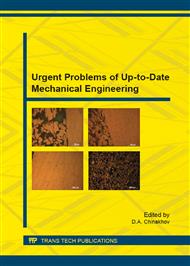p.195
p.200
p.205
p.209
p.216
p.223
p.229
p.242
p.248
Methods of Considering Reliability in the Quality Evaluation Procedure for Composite Metal Cutting Tools
Abstract:
In terms of method for evaluating the quality of composite metal cutting tools, a need to regard reliability as a factor, consisting of several components, is grounded. It is discovered, that thermal compatibility of processed material and material of the tool, has a significant impact on composite cutters’ durability. So does the force of stress, created in the cutting edge. In order to take all these factors into account when evaluating the quality of metal cutting tools, the need to include stress and thermal compatibility coefficients has been proven. Means to determine the attributes needed and formulas for calculation of those coefficients had been developed. The methods we created can be used for the evaluation of both the existing tools and for the perspective tools currently being developed.
Info:
Periodical:
Pages:
216-220
Citation:
Online since:
June 2015
Authors:
Price:
Сopyright:
© 2015 Trans Tech Publications Ltd. All Rights Reserved
Share:
Citation:


